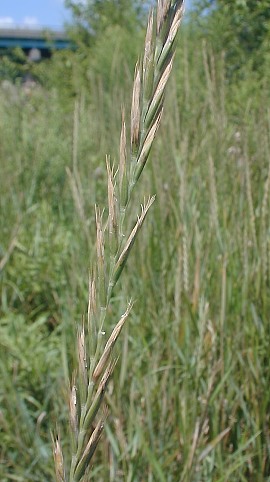 Description: This introduced grass is about
2-3' tall and unbranched, although it may tiller at the base and send up
multiple culms. The culms are green, terete, and hairless. Along each culm are
3-6 alternate leaves. Each leaf blade is up to 8" long and 1/3" (10 mm.)
across, or a little larger in size; it is dull green or greyish blue, ascending
at the base near the culm, and curving outward or downward toward its tip. The
upper surface of the leaf blade is hairless to sparsely short-pubescent and
rough, while the lower surface is hairless and more smooth-textured. At the
base of each leaf blade, there is a pair of slender auricles (ear-like lobes)
that wrap around the culm. Each leaf sheath is dull green or greyish blue, and
either hairless or pubescent. The culm terminates in a spike-like raceme up to
8" long that is stiff and erect. Along this raceme are spikelets up to 2/3" (20
mm.) long that alternate along each side of its central axis on short
peduncles. These spikelets are appressed to slightly spreading and dull green
to greyish blue; with maturity, they become light brown or straw-colored. Each
spikelet consists of a pair of glumes at the bottom and 3-7 florets with their
pairs of lemmas above. In each spikelet, the pairs of lemmas are densely
crowded together. Each glume is about 1/3" (10 mm.) long and linear-lanceolate
in shape; there are several fine longitudinal veins along its outer surface.
The tip of each glume is acute or short-awned. Each lemma is about 1/3" long
and linear to linear-lanceolate in shape. The typical form of Quack Grass has
awnless lemmas (or with short insignificant ones), while f. aristata has
lemmas with awns up to 1/3" (10 mm.) long. The short blooming period occurs
during the summer; the florets are wind-pollinated. Upon maturity, each
spikelet easily detaches from its base and falls in its entirety to the ground;
the individual glumes and lemmas do not separate as readily from each other.
The individual grains are pale yellow to light tan, oblongoid, and somewhat
flattened. The root system is fibrous and produces long rhizomes. Vegetative
colonies are often formed.
Description: This introduced grass is about
2-3' tall and unbranched, although it may tiller at the base and send up
multiple culms. The culms are green, terete, and hairless. Along each culm are
3-6 alternate leaves. Each leaf blade is up to 8" long and 1/3" (10 mm.)
across, or a little larger in size; it is dull green or greyish blue, ascending
at the base near the culm, and curving outward or downward toward its tip. The
upper surface of the leaf blade is hairless to sparsely short-pubescent and
rough, while the lower surface is hairless and more smooth-textured. At the
base of each leaf blade, there is a pair of slender auricles (ear-like lobes)
that wrap around the culm. Each leaf sheath is dull green or greyish blue, and
either hairless or pubescent. The culm terminates in a spike-like raceme up to
8" long that is stiff and erect. Along this raceme are spikelets up to 2/3" (20
mm.) long that alternate along each side of its central axis on short
peduncles. These spikelets are appressed to slightly spreading and dull green
to greyish blue; with maturity, they become light brown or straw-colored. Each
spikelet consists of a pair of glumes at the bottom and 3-7 florets with their
pairs of lemmas above. In each spikelet, the pairs of lemmas are densely
crowded together. Each glume is about 1/3" (10 mm.) long and linear-lanceolate
in shape; there are several fine longitudinal veins along its outer surface.
The tip of each glume is acute or short-awned. Each lemma is about 1/3" long
and linear to linear-lanceolate in shape. The typical form of Quack Grass has
awnless lemmas (or with short insignificant ones), while f. aristata has
lemmas with awns up to 1/3" (10 mm.) long. The short blooming period occurs
during the summer; the florets are wind-pollinated. Upon maturity, each
spikelet easily detaches from its base and falls in its entirety to the ground;
the individual glumes and lemmas do not separate as readily from each other.
The individual grains are pale yellow to light tan, oblongoid, and somewhat
flattened. The root system is fibrous and produces long rhizomes. Vegetative
colonies are often formed.